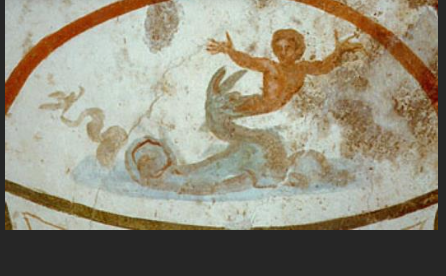medieval art
1/5
There's no tags or description
Looks like no tags are added yet.
Name | Mastery | Learn | Test | Matching | Spaced |
|---|
No study sessions yet.
6 Terms
Catacombs of saint Peter and Marcillenus: Rome,Italy , 3rd century
What is it? This is a catacomb, an underground Christian burial site.
Technique: painted fresco on stone
Scale : The fresco covers the entire ceiling of a burial chamber, ensuring visibility from below.
Composition: A central circular image (Good Shepherd) is surrounded by smaller medallions with biblical scenes..
Materials : Created using natural pigments mixed with lime plaster.
Style : Simple, stylized figures with minimal perspective, common in early Christian art.
Meaning: early christians used symbols in catacombs because open worships were risky, using roman artistic style but added chrtisitian meaning.
name
Scale Composition
Technique
Materials
Style
meaning
Good Shepard motif
Scale : framed within a circular border, making it the focal point.
Composition: Christ is at the center, carrying a sheep on his shoulders, with additional sheep surrounding him, reinforcing the pastoral theme.
Technique : Fresco painting with soft, blended colors, but lacking detailed realism.
Materials: Natural pigments on plaster, ensuring longevity in the underground catacomb.
Style : Figures are symbolic rather than highly detailed, borrowing from Roman artistic traditions but adapted for Christian storytelling.
depicts Jesus as a shepherd carrying a lamb, symbolizing guidance and protection.

Jonah and the whale
The story of Jonah and the Whale is an example of Old Testament typology, foreshadowing Christ’s death and resurrection.
Artistic Style :The image is simple, with flat colors and minimal shading, characteristic of Early Christian frescoes.
Orant-Like Gesture: The raised arms suggest prayer, relief, or divine salvation, connecting it to the broader Christian theme of faith and deliverance.
Symbolism : The whale is stylized, almost dragon-like, showing that Early Christian artists focused more on meaning than realism.Jonah and the Whale – Represents resurrection and salvation (Jonah survives in the belly of the whale for three days, like Christ’s resurrection).
orant figure
Pose – The figure stands with arms raised in prayer, a classic Orant gesture.
Clothing – Wears a long robe, emphasizing reverence and devotion.
Symbolism – Represents a soul in prayer or salvation, a common theme in early Christian funerary art.
Context – Found in the Catacomb of Saints Peter and Marcellinus, among other biblical scenes like Jonah and the Whale and the Good Shepherd motif.
Function – Serves as an intercessory figure, symbolizing the faithful praying for salvation and eternal life.